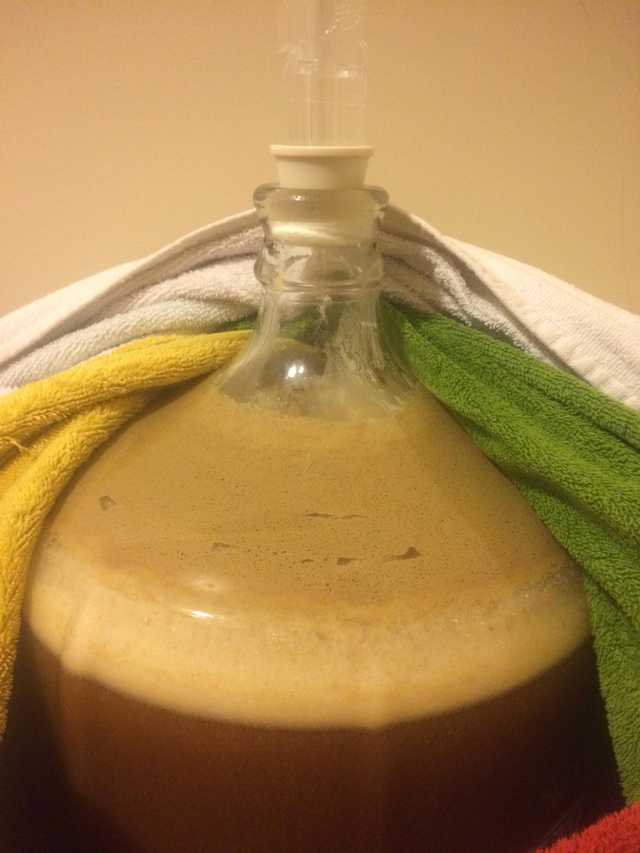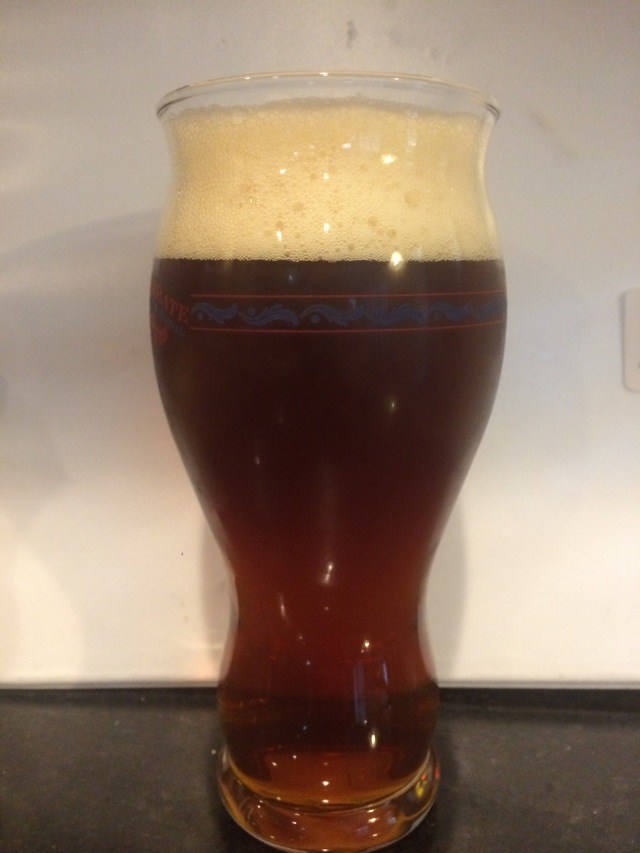This post is one in a series of making small adjustments to a single recipe in order to improve it, learn more about the impact each ingredient has on the finished product, and the art of recipe creation. The rest of the series can be found here.
Brew Day
Some days everything goes right. After my last debacle with overshooting my OG (even after taking steps to avoid my OG fluctuating between batches with the same grist), to say I was getting tired of inconsistency would be a gross understatement. Having taken all other precautions to ensure consistency between batches of this red IPA and screwing up Iteration 7 by simply not looking back at my notes was the final straw in me relying on memory alone for brew days.
After triple checking my notes for proper volumes, I mashed in and took my daughter for a ride down the street in her wagon. I checked on my mash about 20 minutes later, both to stir and to check the temperature, and I found that my temperature was a little lower than desired (148⁰ F with a target of 150⁰ F). I consulted an online step mash calculator to determine how much boiling water I needed and mixed that in my mash to bring it up to my target temperature.
After putting the little one to bed, I returned to the garage and drained my first runnings. A couple batch sparges later and I had my boil going. After all was said and done, I checked my OG and confirmed that I’d hit the same OG as Iteration 6, which was my target gravity. I pitched my yeast into a (slightly too full) carboy and went to bed. Two days later the krausen had risen dangerously high and I had to set up a blow-off tube for only the second time in my six years of brewing.

Recipe
Iteration 7 had an ABV that was higher than I wanted (straying into the DIPA realm at 8.3%) and lacked the hop aroma that I’d had in previous versions of this red IPA recipe. The ABV had an easy enough remedy (pay attention to volumes gathered, you idiot). The hop question also seemed to have a pretty straightforward answer (add more hops). The way that hops interact, though, and result in a whole that is greater than the sum of its parts—that’s what makes hops difficult for me. The recent research into hop oils and how they interact clearly shows that changing one thing with your hopping regimen is never truly changing only one thing. The questions I had after trying Iteration 7 were:
- Which additional hop should I add to the dry hop to improve aroma (a new hop or one already in use)?
- Which hop should I use to get a more prominent citrus flavor?
- Should I add more hops at flameout in addition to more dry hops? If so, which ones?
The hops I was already using were definitely giving me the flavors and aromas I wanted, so I decided to avoid bringing another hop into the mix. The first two questions above, though, were hard for me to deal with separately. Truly, it seemed as though I should approach them together to achieve the desired result. Lastly, considering what was mentioned above about hops interacting together, I knew I couldn’t simply increase all of my hops equally as that would likely yield the change in intensity I wanted but not the change in flavor/aroma character I wanted. It seemed most logical to me to increase the amount used of only one hop for now to begin to determine which hops I needed more of since equal amounts weren’t yielding the desired result.
Considering these factors, I didn’t think that adding more Amarillo alone wouldn’t give me the citrus flavor/aroma I wanted more of. While this hop can give citrus character, I was getting a distinctly apricot flavor and aroma from it. This left me to choose between centennial and cascade. Both of these have reputations for having citrus characteristics, so I began to examine the oil content of each in hopes of narrowing my choices.
In addition to wanting more citrus character, I wanted to do so without also increasing the floral notes I’ve been getting from previous versions of this recipe. While centennial has geraniol (the oil cited as having the biggest impact on floral character) in a range of 1.2-1.8% of the total oils, geraniol only makes up 0.2% of cascade’s total oils. This seemed like a good enough reason to try upping the cascade dry hop additions.
Addressing my final question from the last iteration about more hops at flameout, since I wanted to only increase one hop in one area (kettle addition or dry hop) at one time, I decided to go a slightly different route to hopefully achieve a similar impact (though I didn’t expect it to be as prominent of an impact). Rather than adding more hops to the kettle, I moved my (previous) 15 minute cascade addition to 10 minutes and waited to add my flameout addition of Amarillo until my wort was at 180⁰ F, effectively making that addition as much of a whirlpool addition as I could with my setup (in other words, a hop stand).
All of these considerations came together to form this recipe:
- Mashed at 150⁰ F for 1.25 hrs.
- 10 lbs. 2-Row
- 1.2 lbs. Crystal 120
- 1 lb. Vienna
- Boiled for 1 hr.
- 0.5 oz. Magnum (60 min) at 14.7% AA
- 0.5 oz. Magnum (30 min) at 14.7% AA
- 0.5 oz. Cascade (10 min) at 5% AA
- 0.5 oz. Centennial (5 min) at 9.7% AA
- 0.5 oz. Amarillo (hop stand) at 12.9% AA
- Pitched US-O5
- OG: 1.066
- FG: 1.010
- ABV: 7.35%
- Dry hopped 1.5 oz. Cascade, 0.5 oz. Centennial, and 0.5 oz. Amarillo for 5 days.
- Bottled and primed with 4 oz. of priming sugar.
Tasting
This iteration poured with an excellent head and had good retention. The color was satisfyingly red—and the beer was clear. I did pour this beer at a slightly higher temperature than I usually do, which seems to confirm my previous determination that chill haze has been my issue all along.

This beer had an aroma of cherry, citrus, and plum, with background floral notes and a hint of caramel. The caramel nose is not something I’ve noticed before with this malt bill, but it’s something I’ll look for again in future tastings and future iterations, as it was not an ideal aroma mixed with the others that I found quite enjoyable.
The flavor of this beer was (in order of prominence) orange/grapefruit citrus, red plum, and Bing cherry.
Goals for the Next Brew
This beer is certainly progressing towards the desired end goal. The citrus and dark fruit flavors I noted from this version of the recipe are in line with what I originally imagined I wanted this beer to be. I also think that the adjustment of hop ratios in the dry hop was successful in terms of yielding the citrus character I wanted. One thing it was lacking, though, was the apricot flavor that surprised me in Iteration 7. Although that wasn’t originally intended to be part of the flavor profile, it did add a level of complexity that I wouldn’t mind bringing back.
Mostly, though, I think this beer is almost where it needs to be. What is conspicuously lacking from this red IPA is the IPA-level of hop aroma. While it does have a more intense hop aroma than a standard red or amber, it’s more in line with the aroma one would expect from a pale ale rather than an IPA. I knew from the start that I would need more hops to achieve the level of aroma I needed, but I wanted to focus on getting the flavors right first. Now that I’m happy with the type of aroma and flavor, it’s time to increase it so that I can also be happy with the level of aroma and flavor. This leaves me with two questions:
- How much hops do I need to achieve the level of flavor/aroma desired?
- How should I tweak my dry hop ratios to keep the citrus flavor from this iteration while getting the apricot notes from the previous iteration.
Recipe Progression
| Iteration 1 | Iteration 2 | Iteration 3 | Iteration 4 | Iteration 5 | Iteration 6 | Iteration 7 | Iteration 8 | |
| Base Malt 2-row | 10.25 lbs. | 10.25 lbs. | 10.25 lbs. | 9 lbs. | 10 lbs. | 10 lbs. | 10 lbs. | 10 lbs. |
| Crystal Malt | 1 lb. C80 | 1 lb. C120 | 0.75 lbs. C120 | 1.25 lbs. C120 | 1 lb. C120 | 1.2 lbs. C120 | 1.2 lbs. C120 | 1.2 lbs. C120 |
| Specialty Malt | 0.5 lbs. Special B | 1 lb. Munich | 1 lb. Vienna | 1 lb. Vienna | 1 lb. Vienna | 1 lb. Vienna | ||
| 60 min. hop | 0.5 oz. Simcoe | 0.5 oz. Simcoe | 0.5 oz. Simcoe | 0.5 oz. Simcoe | 0.5 oz. Simcoe | 1 oz. Magnum | 0.5 oz. Magnum | 0.5 oz. Magnum |
| 30 min. hop | 0.5 oz. Simcoe | 0.5 oz. Simcoe | 0.5 oz. Simcoe | 0.5 oz. Simcoe | 0.5 oz. Simcoe | 0.5 oz. Magnum | 0.5 oz. Magnum | |
| 15 min. hop | 0.5 oz. Cascade | 0.5 oz. Cascade | 0.5 oz. Cascade | 0.5 oz. Cascade | 0.5 oz. Cascade | 0.5 oz. Cascade | 0.5 oz. Cascade | |
| 10 min. hop | 0.5 oz. Centennial | 0.5 oz. Cascade | ||||||
| 5 min. hop | 0.5 oz. Centennial | 0.5 oz. Centennial | 0.5 oz. Centennial | 0.5 oz. Centennial | 0.5 oz. Centennial | 0.5 oz. Centennial | 0.5 oz. Centennial | |
| 0 min. hop | 0.5 oz. Simcoe | 0.5 oz. Amarillo | 0.5 oz. Amarillo | |||||
| Dry hop | 0.5 oz. Cascade & Centennial | 0.5 oz. Cascade & Centennial | 0.5 oz. Cascade & Centennial | 0.5 oz. Cascade & Centennial | 0.5 oz. Cascade & Centennial | 0.5 oz. Cascade, Centennial, & Simcoe | 0.5 oz. Cascade, Centennial, & Amarillo | 1.5 oz. Cascade; 0.5 oz. Centennial & Amarillo |
| OG | 1.059 | 1.064 | 1.056 | 1.052 | 1.056 | 1.066 | 1.073 | 1.066 |
| FG | 1.008 | 1.010 | 1.008 | 1.010 | 1.008 | 1.010 | 1.010 | 1.010 |
| ABV | 6.7% | 7.1% | 6.3% | 5.5% | 6.3% | 7.4% | 8.3% | 7.4% |
